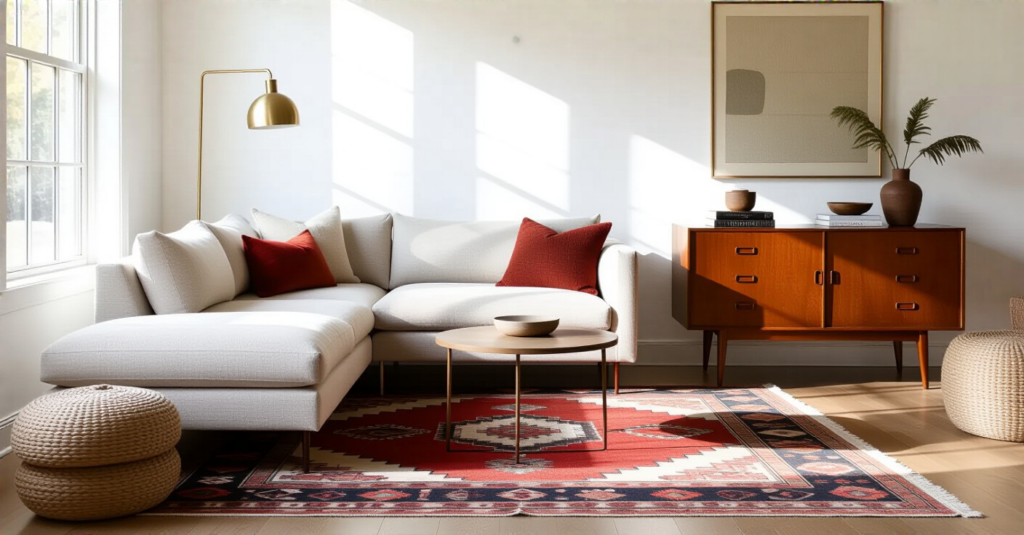You know what people always ask me? They’ll see a photo of a beautifully layered, interesting room and say, “How do I get that look? Mine just looks…messy.” And that’s the whole ballgame right there. Everyone thinks eclectic design means you just throw all the stuff you love into a room and hope for the best. That’s a recipe for creating a high-end garage sale, not a home. It’s the visual equivalent of shouting.
The real secret isn’t in the stuff. It’s in the threads that connect the stuff. True eclectic design is an art of thoughtful curation, like making an incredible soup. You need a rich, flavorful broth—a foundation of color, texture, and scale—that lets all the unique ingredients (your vintage finds, your modern sofa, that weird lamp you love) sing together instead of fighting for attention. It’s about creating harmony from contrast, and once you understand that, you can create a room that feels like it’s giving you a hug.
Laying the Eclectic Foundation
This is the part that isn’t as flashy as picking out pillows, but I promise you, it’s the most important. Getting this groundwork right is what allows all the fun, quirky, and beautiful pieces to feel like they belong together. This is where we make the broth.
1. Define Your Personal Style Core
Forget what the catalogs tell you. The first step is to figure out the feeling you want. Do you want your room to feel like a moody, tweed-and-leather library where you’d sip whiskey? Or more like a sun-drenched, linen-and-rattan artist’s loft? Pick a core vibe. This will be your “lead singer”—the style that makes up about 60-70% of your room, usually the big stuff like your sofa and rug. Then, you pick your “backup singers”—one or two other styles that you’ll sprinkle in as accents.
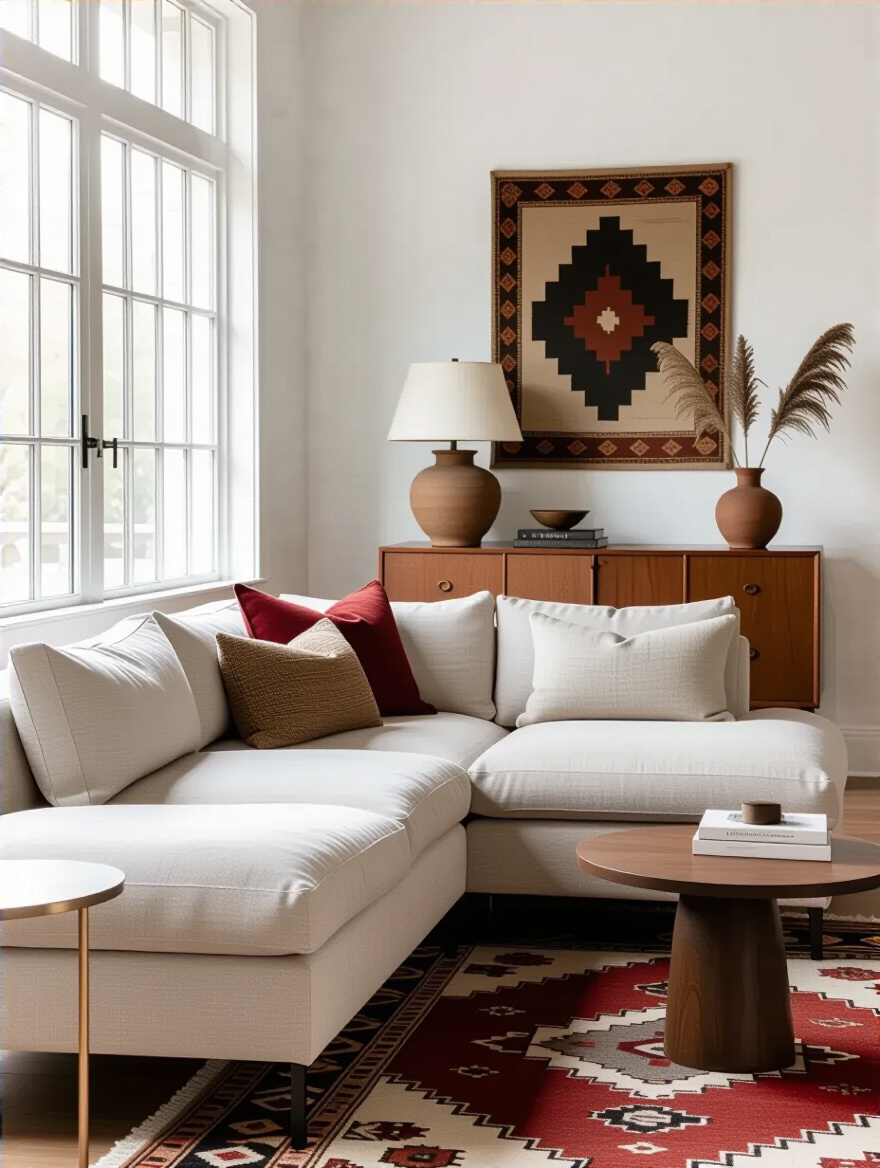
I once worked with a client who loved both sleek minimalism and cozy bohemian decor. Her first attempt was a mess of concrete tables and macrame wall hangings that looked like they were in a silent fight. We fixed it by committing to a minimalist foundation: a clean-lined sofa, a simple metal-frame coffee table. Then we brought in the boho as the 30% accent: nubby wool pillows, a vintage Turkish rug, and lots of plants in terracotta pots. The result was calm but full of personality, because every piece had a clear role.
With your core feeling established, you can start speaking its language through color.
2. Establish a Unifying Color Palette
This is your single greatest tool for making mismatched things feel intentional. The BS everyone falls for is thinking an eclectic room needs every color of the rainbow. No. It needs a disciplined palette. The easiest way to do this is the 60/30/10 rule. Your 60% is your dominant, usually neutral, color. Think of it as the air in the room—it’s the walls, the sofa, the main rug. It’s the backdrop.
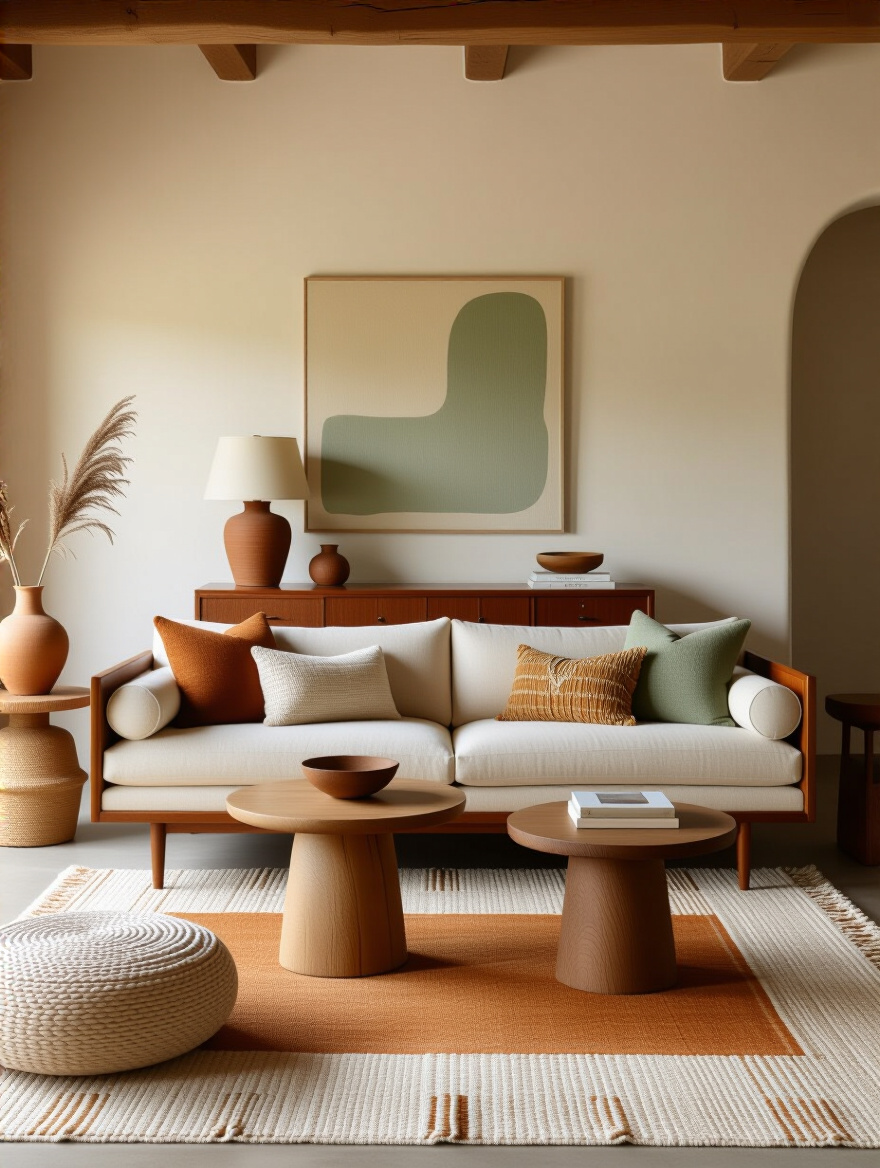
Then, your 30% is a secondary color or two. This is for your curtains, an accent chair, maybe some larger pillows. It’s your supporting cast. Finally, 10% is your pop of pure joy. A flash of mustard yellow in a single cushion, a vibrant magenta in a vase, a bit of black to ground everything. My shortcut? Go to the hardware store, grab a few paint chip cards you love, and stick them in your wallet. When you’re out thrifting or shopping, you can hold them up to a potential purchase. If it doesn’t work with your colors, leave it behind, no matter how much you love it.
Now that you’ve got your colors, you need to pick the star of the show.
3. Choose a Dominant Furniture Piece
Every room needs a sun for the other planets to orbit around. This is usually your sofa. And it needs to have presence. It doesn’t just have to be the longest thing in the room; it needs visual weight. A plush, deep-seated velvet chesterfield has incredible weight because of its texture and classic form. A sleek, low-profile sectional can have weight if it’s in a bold, saturated color. Don’t be afraid to let this one piece really command the space.
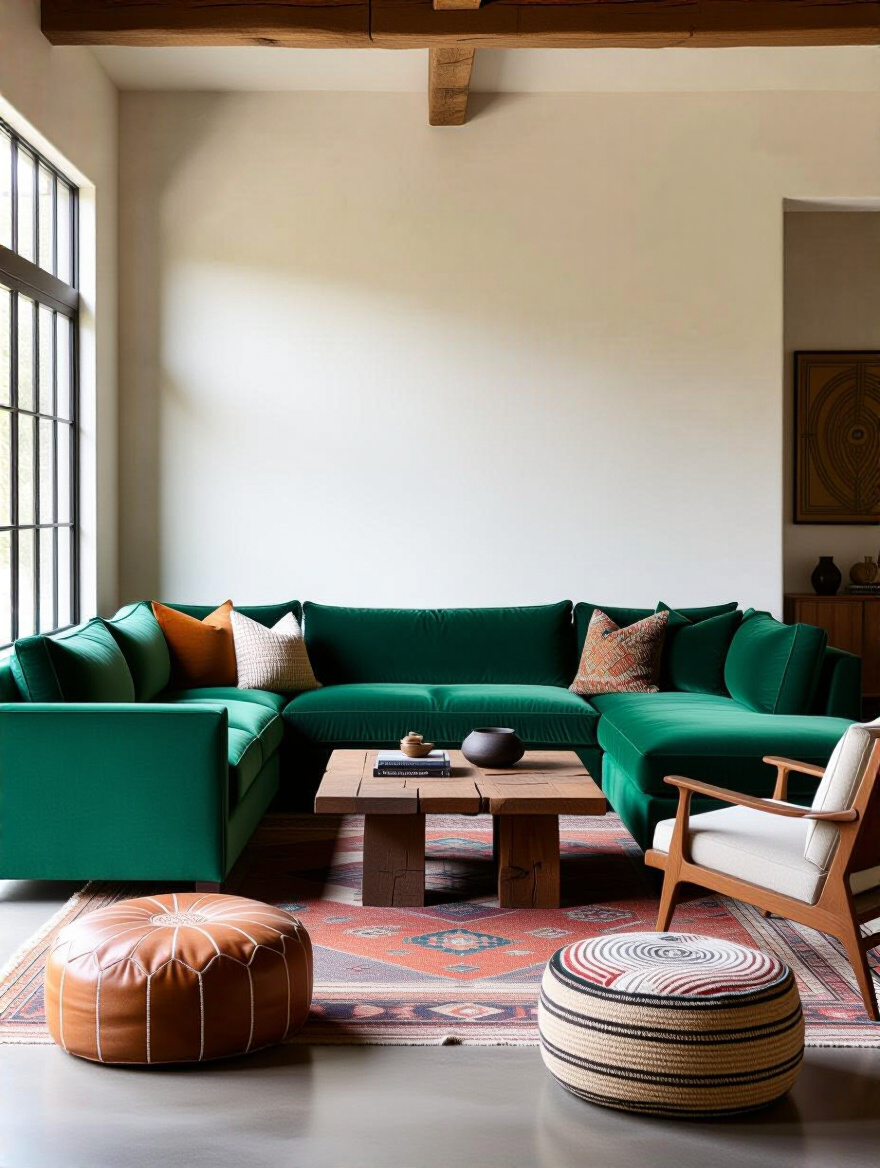
I learned this the hard way in my first apartment. I had a bunch of small, “apartment-sized” pieces—a small loveseat, two different little armchairs, a tiny coffee table. Nothing felt grounded. It was a collection of floating objects. The day I swapped it all for one big, comfortable, slightly-too-large-for-the-room sectional, the entire space suddenly made sense. Everything else just fell into place around it. It gave the room an anchor and, counterintuitively, made it feel bigger and more luxurious.
Once your anchor is set, it’s time to play with all the shapes that will surround it.
4. Incorporate Varying Silhouettes and Scales
Can we please talk about why everyone is still buying matching three-piece suites? It’s the fastest way to make a room feel flat and boring. You need contrast in shapes. Think of your room like a city skyline: you need skyscrapers, mid-rise buildings, and little shops to make it interesting. If your sofa is low and chunky, pair it with armchairs that are “leggy” and sit high off the floor. If your coffee table is a solid block of wood, make sure your side tables are delicate with thin metal legs.

The key is to create a rhythm of high and low, heavy and light, curvy and straight. This is what keeps the eye moving around the room and makes it feel dynamic and curated. Don’t be afraid to put a curvy, ornate vintage chair right next to a square, modern bookshelf. The tension between those two shapes is where the magic happens. It’s what tells the story of a home collected over time, not bought in an afternoon.
Mixing & Matching Major Elements
Okay, the foundation is set. Now we get to the really fun part—bringing in the big pieces that will define the character and comfort of your living room. This is all about confident juxtaposition.
5. Balance Hard and Soft Textures
As a textile person, this is my religion. A room without a rich mix of textures is a room without a soul. It’s just flat. You have to create a conversation between the hard and the soft. Run your hand across the cool, smooth surface of a marble coffee table. Now imagine sinking your feet into a deep, plush wool rug right next to it. That contrast is everything. If you have a sleek leather sofa, you need to drape a chunky, hand-knit throw over it and pile on some soft, maybe even slightly fuzzy, bouclé pillows.
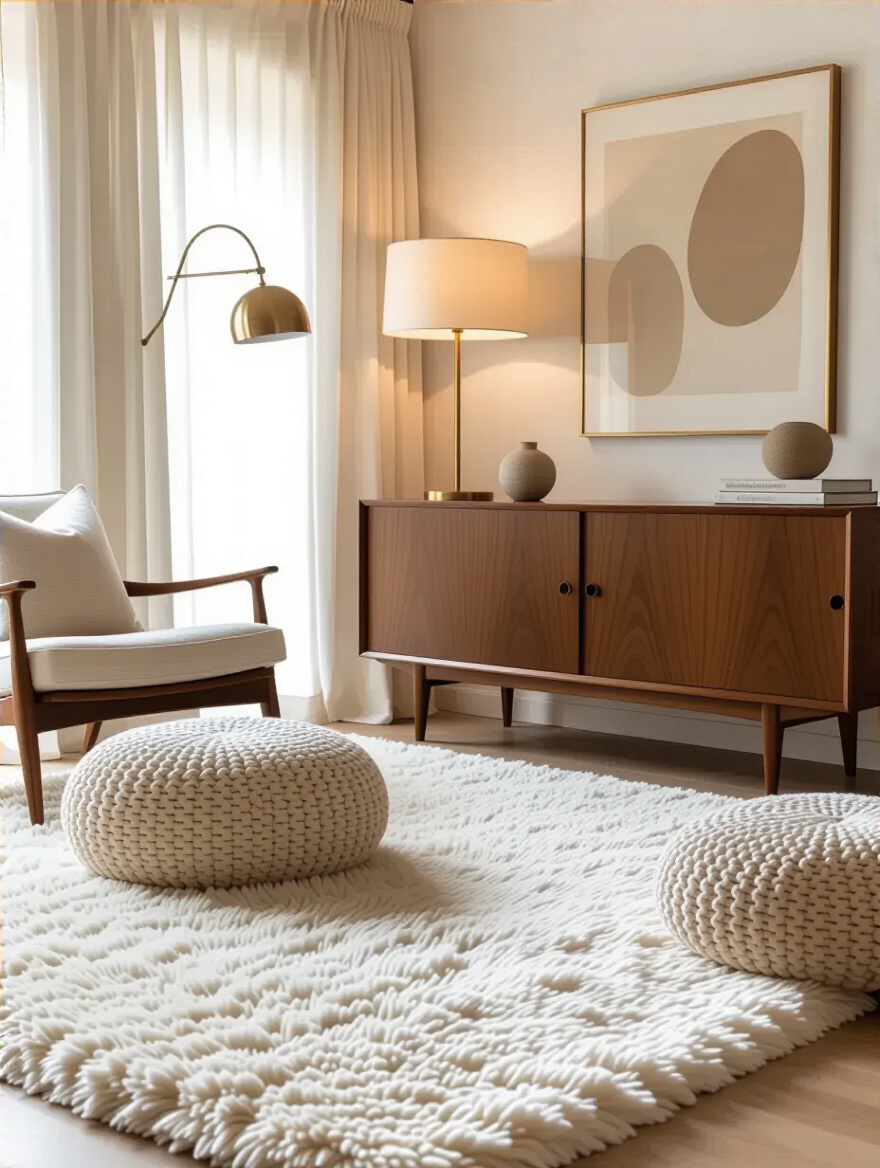
A good shortcut is the 70/30 rule. Let one textural family be the star—say, 70% soft, with a fabric sofa, thick curtains, and a soft rug. Then, your 30% comes from the hard-edged accents: a glass table, a metal floor lamp, ceramic vases. I once walked into a client’s home that was all hard surfaces—leather couch, tile floor, glass tables. It felt cold and echoed like a train station. We didn’t change a single piece of furniture. We just added a massive, high-pile shag rug, velvet curtains, and a bunch of chenille pillows. The room was instantly transformed into a cozy, inviting space. That’s the power of texture.
Once you have that beautiful contrast of hard and soft, you can bring that same mindset to the art on your walls.
6. Curate Art Across Eras and Mediums
Here’s the BS everyone believes about art: that it has to be expensive, and it has to “match.” Wrong. Your art collection should be as eclectic as your furniture. The most interesting gallery walls mix a modern abstract print, an old-timey oil painting of a ship you found at a flea market for $10, and a framed piece of your kid’s kindergarten art. The contrast is what makes it personal and cool.
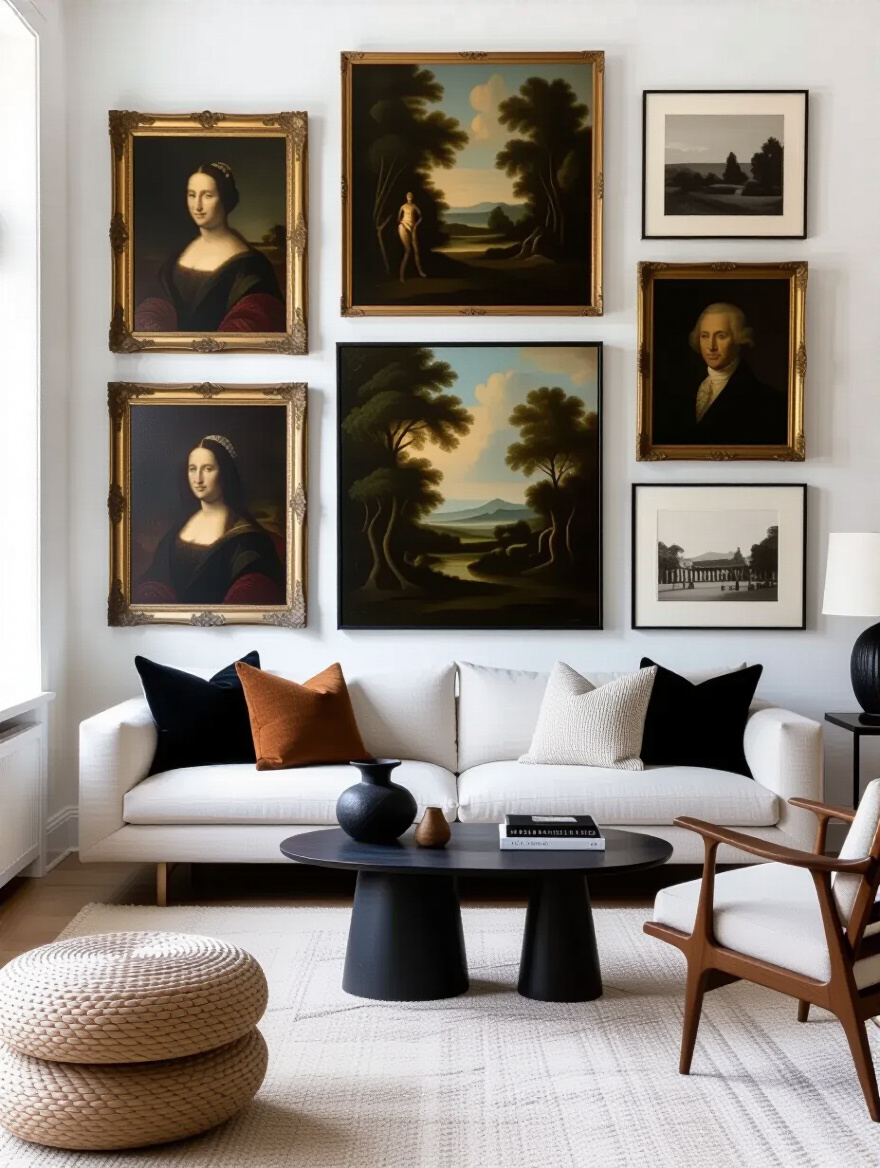
My favorite shortcut for this is to unify with frames. You can make a wild collection of stuff feel cohesive by putting everything in simple black or natural wood frames. Or, go the other way and mix the frames, too! An ornate gilded frame next to a sleek modern one creates fantastic tension. The point isn’t to create a museum; it’s to hang things that mean something to you. A framed concert ticket stub next to a beautiful photograph can tell a much better story than a generic, mass-produced canvas print from a big-box store.
This idea of telling a story extends to objects that come from all over the world.
7. Introduce Global-Inspired Finds Authentically
Let’s be clear: this isn’t about creating an “around the world in 80 days” theme park. It’s about honoring craftsmanship and story. One authentic, hand-carved wooden stool from Ghana that you use as a side table has more soul than a dozen mass-produced “tribal-print” pillows from a chain store. Authenticity is everything. Seek out pieces with provenance—things you found on your travels or bought from fair-trade cooperatives that support global artisans.
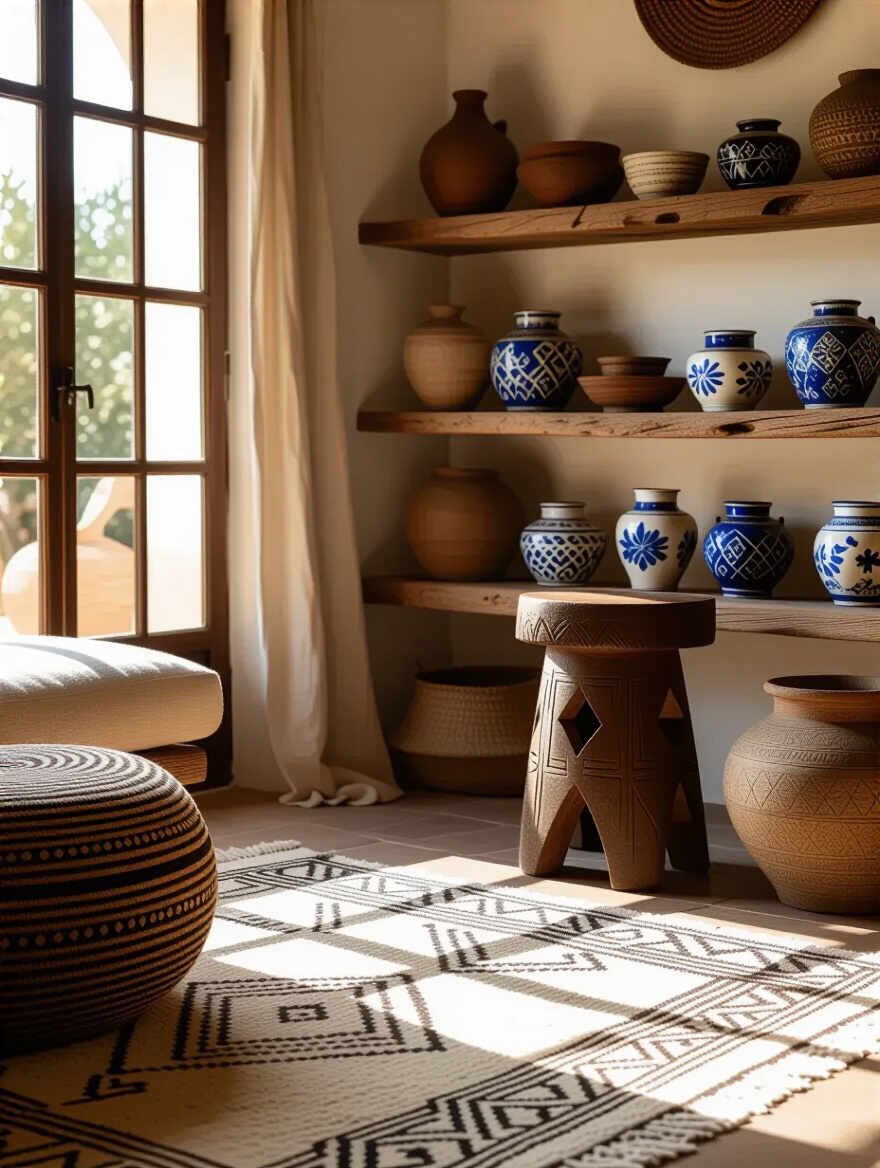
When you mix these pieces in, let them breathe. Don’t cram them all together. A beautiful Beni Ourain rug from Morocco can be the soft, neutral foundation for a room full of mid-century furniture. A collection of hand-painted ceramics from Portugal can live on a modern, minimalist bookshelf. The key is to integrate them into your style, not to let them take over and turn your living room into a caricature. This approach adds a layer of warmth and history that feels genuinely collected and well-traveled.
Those collected pieces will look best when they’re part of a truly inviting seating area.
8. Blend Traditional and Modern Seating
This is one of the quickest ways to achieve a high-end, designer look. Pair a classic, rolled-arm sofa with a pair of sleek, Scandinavian-inspired armchairs. Or put a super-modern, low-profile sectional across from a traditional, button-tufted chesterfield. The push and pull between old and new creates instant energy. It also offers different kinds of comfort—some people like to lounge and sink into a modern sofa, while others prefer the more upright, formal posture of a traditional armchair for conversation.
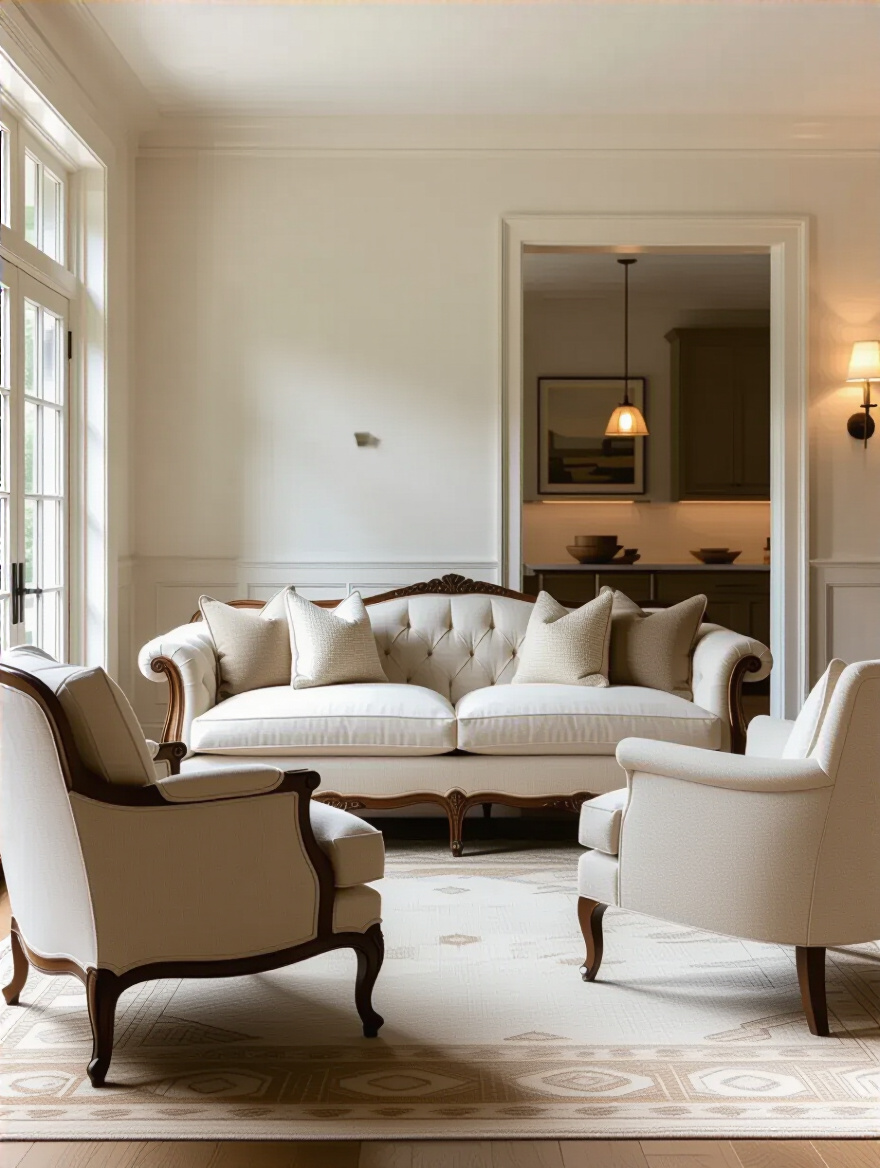
The trick to making it work is to connect them with a thread of consistency. Maybe all the pieces have dark wood legs. Or maybe you use a throw pillow on the modern sofa that pulls a color from the traditional chair’s upholstery. I learned this when I inherited my grandmother’s two very formal, floral wingback chairs. They felt stuffy on their own. But when I placed them opposite my minimalist gray sofa and put a funky, modern floor lamp between them, they suddenly looked incredibly chic and sculptural.
And nothing feels more chic than a piece with a real past.
9. Source Unique Vintage or Antique Treasures
Every room needs at least one thing that’s old. Vintage and antique pieces bring a sense of history and soul that brand-new items just can’t replicate. It could be a mid-century credenza with a beautiful wood grain, an ornate gold-framed mirror with some foxing on the glass, or a wonderfully worn leather club chair. These are the pieces that have stories baked into their very fibers—the nicks, the patina, the gentle wear.

Don’t be afraid of imperfections. That’s the good stuff! The BS is thinking everything has to be pristine. A little bit of wear shows a piece has been lived with and loved. My best advice is to frequent flea markets, antique malls, and estate sales. You’ll find things with far more character—and often for far less money—than anything you could buy new. A vintage steamer trunk as a coffee table isn’t just a table; it’s a conversation.
These treasures need a stage, and that’s where your floor comes in.
10. Utilize Distinct Area Rugs Strategically
Think of area rugs as portable rooms. In an open-concept space, they are your best friend for creating defined zones without putting up walls. A large rug can anchor your main conversation area, instantly making it feel like a self-contained space. A smaller, round rug under an armchair and a floor lamp can create a cozy reading nook in a corner. You’re essentially drawing invisible borders on the floor.

Don’t be afraid to mix patterns, either. As long as they share a color story, you can absolutely put a striped rug near a floral one. A great shortcut for this is layering. Start with a large, neutral, natural-fiber rug like jute or sisal. It adds incredible texture and covers a lot of ground. Then, layer a smaller, more precious, and more colorful vintage rug on top to define a specific seating group. It adds so much depth and makes the space feel incredibly cozy and intentional.
And just like with your rugs, your entire layout doesn’t need to be perfectly matched.
11. Embrace Asymmetrical Layouts Artfully
Symmetry can be beautiful, but it can also be very formal and a little boring. Asymmetry is what makes a room feel lived-in, relaxed, and interesting. It doesn’t mean unbalanced; it just means you’re balancing with visual weight instead of with identical objects. Instead of having a matching sofa and loveseat, try one large sofa balanced by two completely different armchairs on the other side.
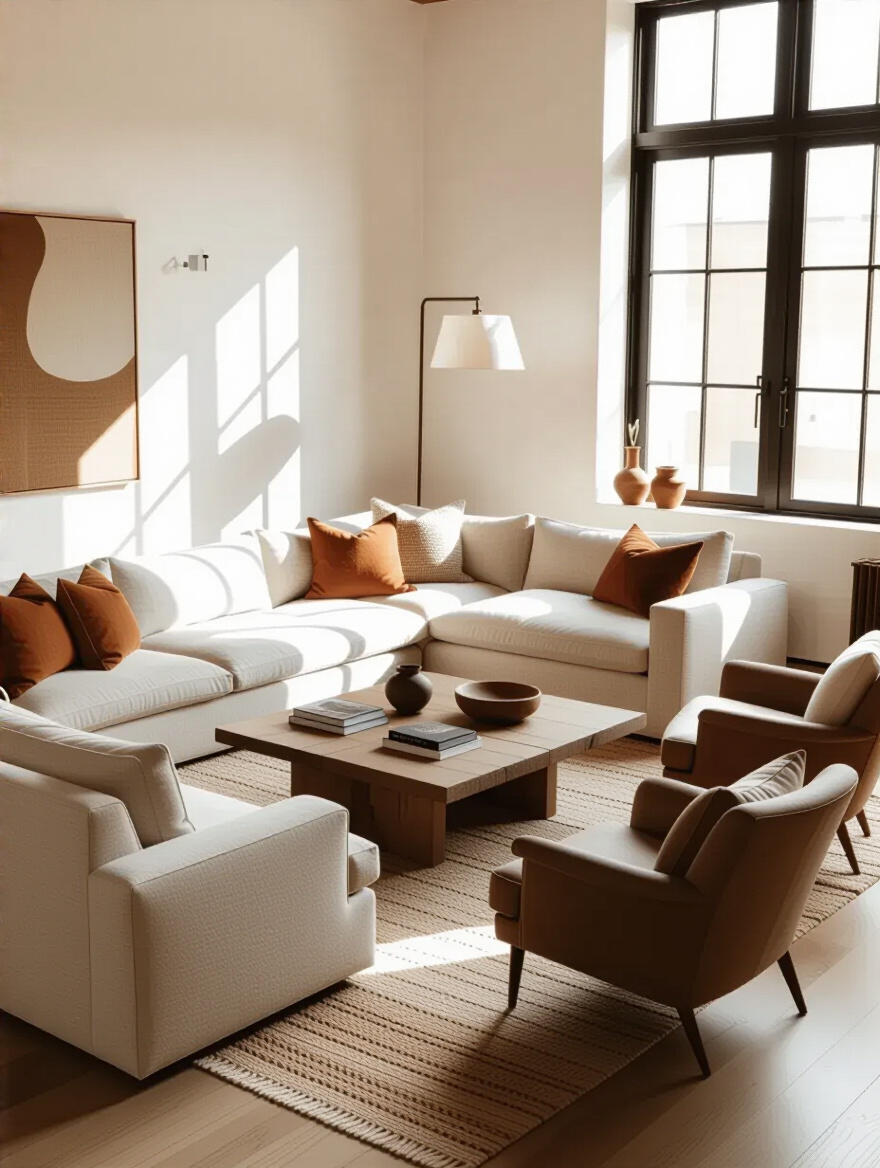
Think of it like balancing a scale. A big, heavy sofa on one side can be balanced by a lighter-weight armchair paired with a tall floor lamp and a large plant on the other. You’re distributing the “visual mass” around the room. I once had a client who was stuck because her fireplace was off-center on the main wall. She kept trying to force a symmetrical layout, and it just looked awkward. We leaned into it, placing the sofa to one side and creating a beautiful, asymmetrical reading nook on the other. It instantly felt more natural and dynamic.
You can even take this a step further by bringing the structure of the building into your decor.
12. Showcase Architectural Salvage as Decor
This is for anyone who wants a home that feels truly one-of-a-kind. Architectural salvage—an old window frame hung on the wall as art, a vintage mantelpiece mounted on a blank wall to create a focal point, a pair of ornate corbels used as a bookshelf—adds a layer of history and grit that is impossible to replicate with new stuff. These pieces have texture, patina, and a story built right in.
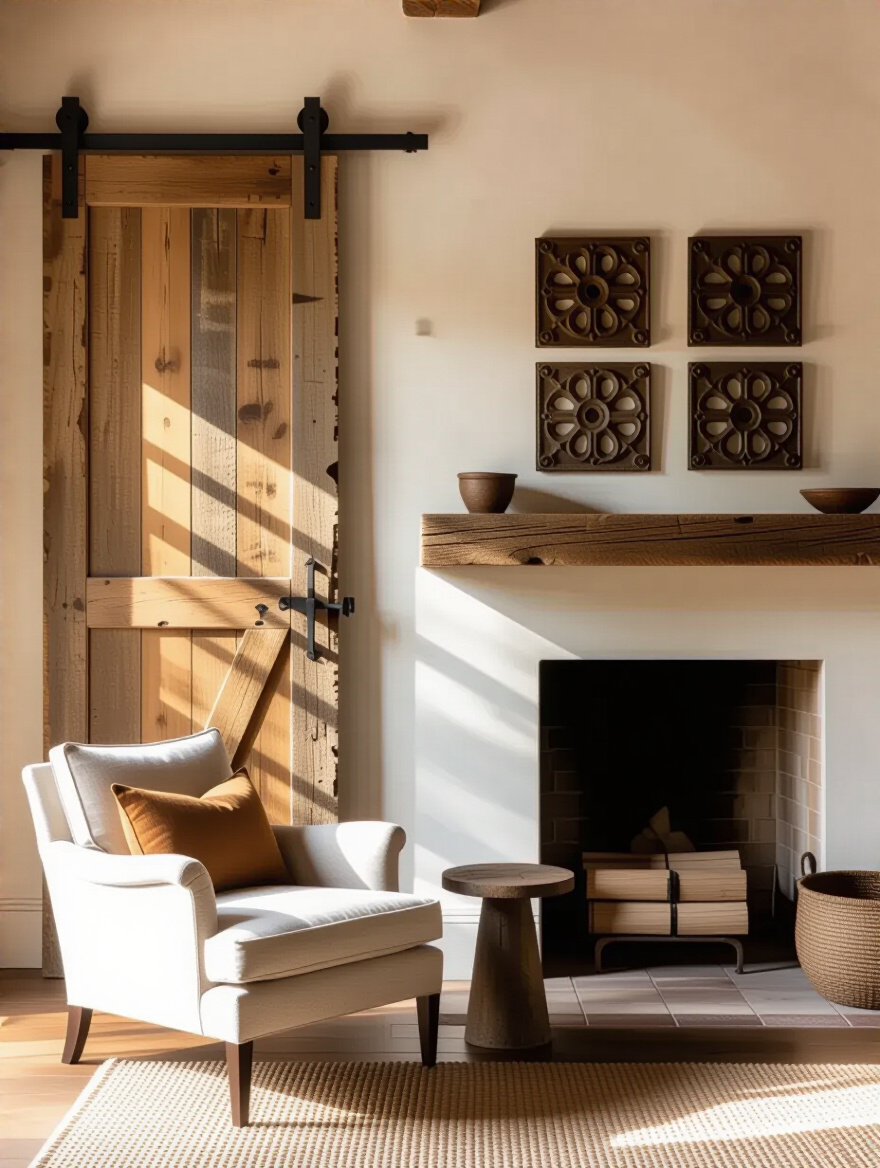
The noise you should ignore is the idea that these things need to be perfectly restored. Sometimes, the peeling paint and rustic finish are the whole point! My personal favorite find was an old, paneled door from a 1920s house. We stripped some, but not all, of the paint, mounted it on a sliding track, and used it as the door to a pantry. It’s the single most commented-on feature in my friend’s house. It has more soul in one of its chipped panels than a whole house full of brand-new things.
Curating Details & Vignettes
The big pieces set the stage, but the details are what tell the intimate stories. This is where you bring in the final layers of touch, light, and personality that make a room truly yours.
13. Layer Diverse Textiles for Warmth
This is my absolute favorite part. You can have the most beautiful furniture in the world, but without layers of textiles, a room will always feel a little cold. This is about creating a feast for the hands as well as the eyes. Think about the mix: a smooth, cool linen pillow next to a chunky, warm wool knit. A soft, drapey cashmere throw over the arm of a structured twill sofa. A plush velvet cushion against a rustic, nubby bouclé chair.
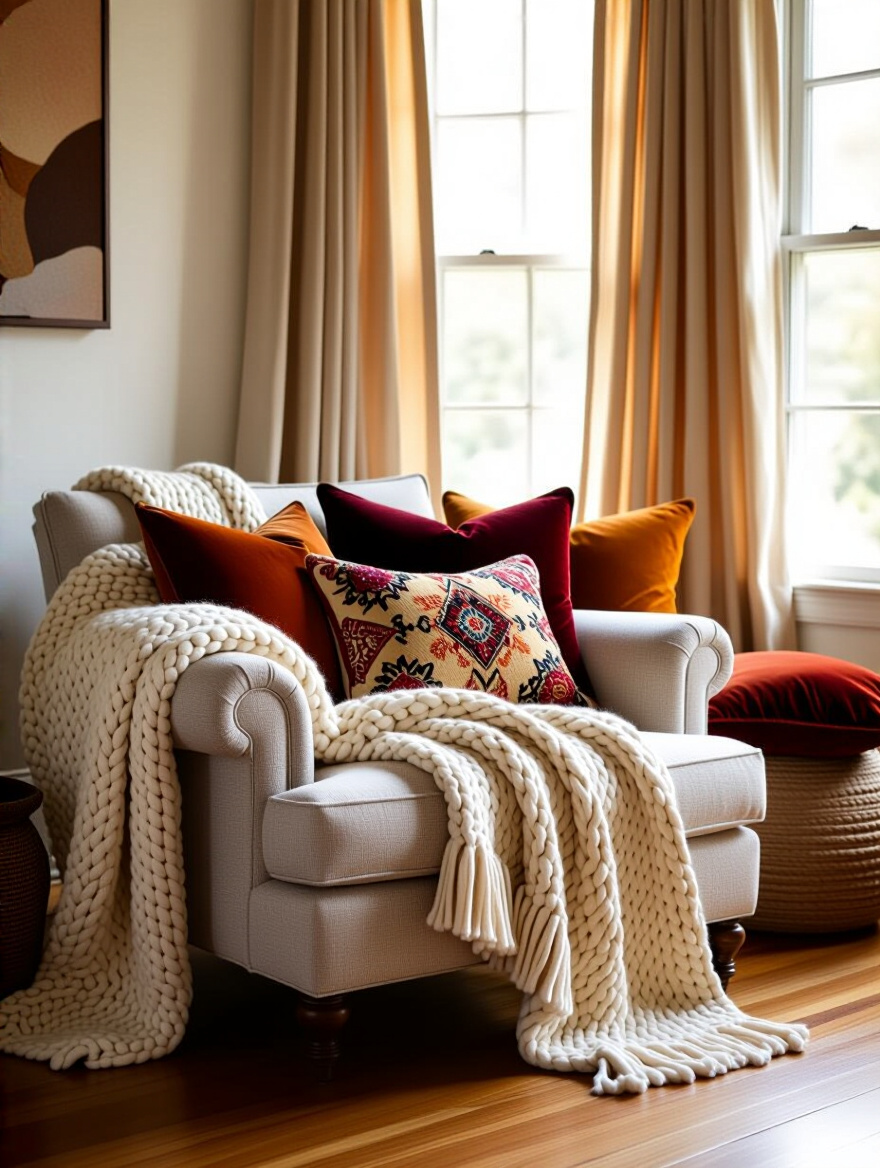
A shortcut I always tell people is to vary not just the texture but the sheen. Mix matte fabrics like cotton and wool with things that have a bit of a glow, like silk or velvet. It catches the light in different ways and adds so much subtle depth. And please, use odd numbers for pillows. A group of three or five always looks more natural and less “staged” than a symmetrical pair. This is how you build that sink-in-and-stay-awhile coziness.
That coziness is amplified a hundred times when you get the lighting right.
14. Mix Lighting Styles and Heights
Please, I’m begging you, stop relying on that one sad overhead light. It casts unflattering shadows and makes everything feel flat. A well-lit room needs at least three layers of light: ambient (the overall glow, from that overhead fixture or recessed lights), task (focused light for reading, like a floor lamp by a chair), and accent (light that highlights something beautiful, like a picture light over art or an uplight behind a plant).
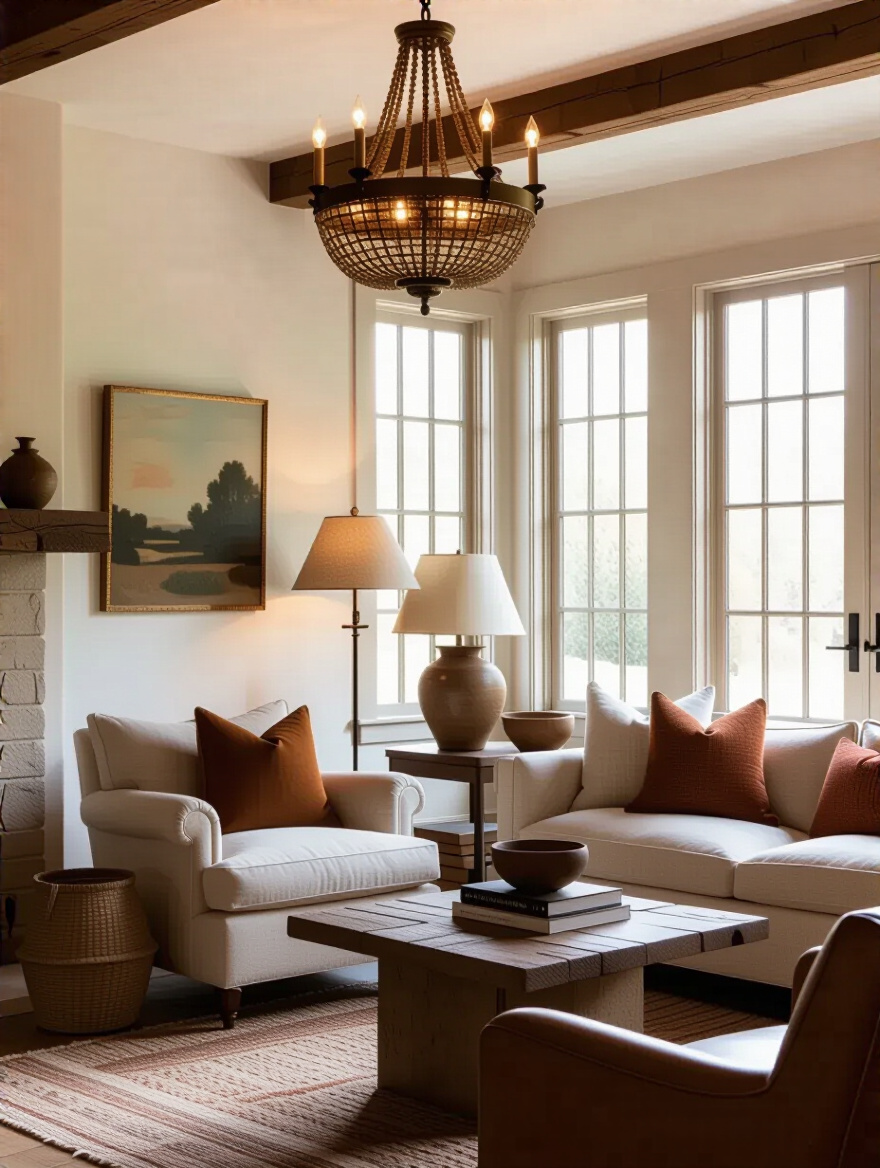
And just like your furniture, your light fixtures should not match! Mix it up. A vintage brass chandelier, a modern, minimalist floor lamp, and a quirky ceramic table lamp can all live happily in the same room. The key is to vary their heights. Having light sources at different levels—overhead, eye-level, and low to the ground—creates pockets of warmth and intrigue. The shortcut: put everything on a dimmer. It’s the single best, and cheapest, way to control the mood of a room.
And in those pools of light, you’ll want to showcase your favorite things.
15. Arrange Personal Collectibles Thoughtfully
This is the difference between a curated display and plain old clutter. You can’t just put all your stuff on a shelf. You need to group things to tell a story. Gather your collection of vintage cameras together. Group your blue and white pottery. Put all your travel mementos from that trip to Mexico in one area. By creating little families of objects, you give them more power.
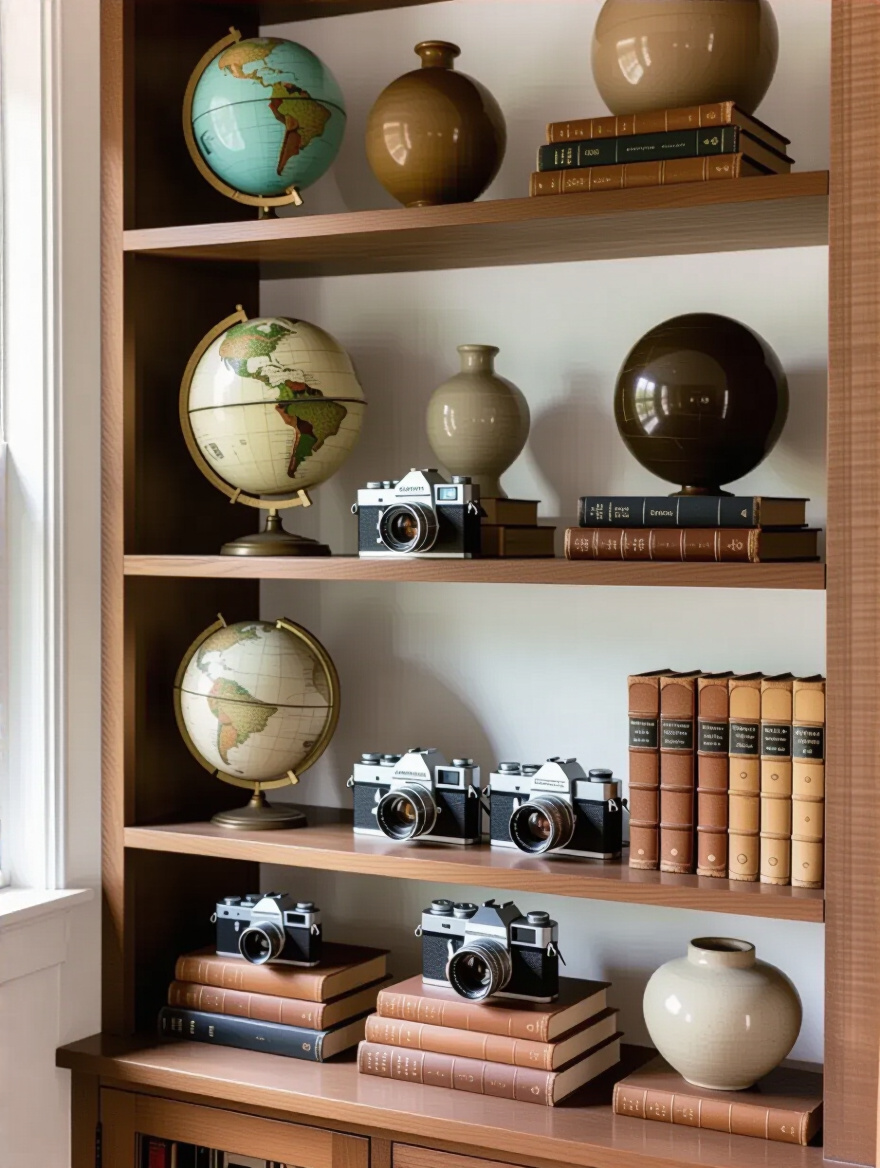
The secret here is the “Rule of Three” and varying heights. A vignette always looks better with an odd number of items, and you need something tall, something medium, and something small. Stack some books to create a riser for a smaller object. Lean a small piece of art at the back. It’s about creating a landscape on your tabletop, not a flat line of stuff. And please, leave some empty space. Negative space gives the eye a place to rest and makes the objects you do display feel more important.
One of the best things to add to these collections is something living.
16. Integrate Lush Greenery and Plants
Every single room, without exception, needs something alive in it. Plants add an organic shape and a shot of natural color that no man-made object can replicate. They soften hard edges, purify the air, and literally bring life into your space. A tall Fiddle Leaf Fig can provide a beautiful vertical element in a corner, while a trailing Pothos can spill gracefully from a high shelf.
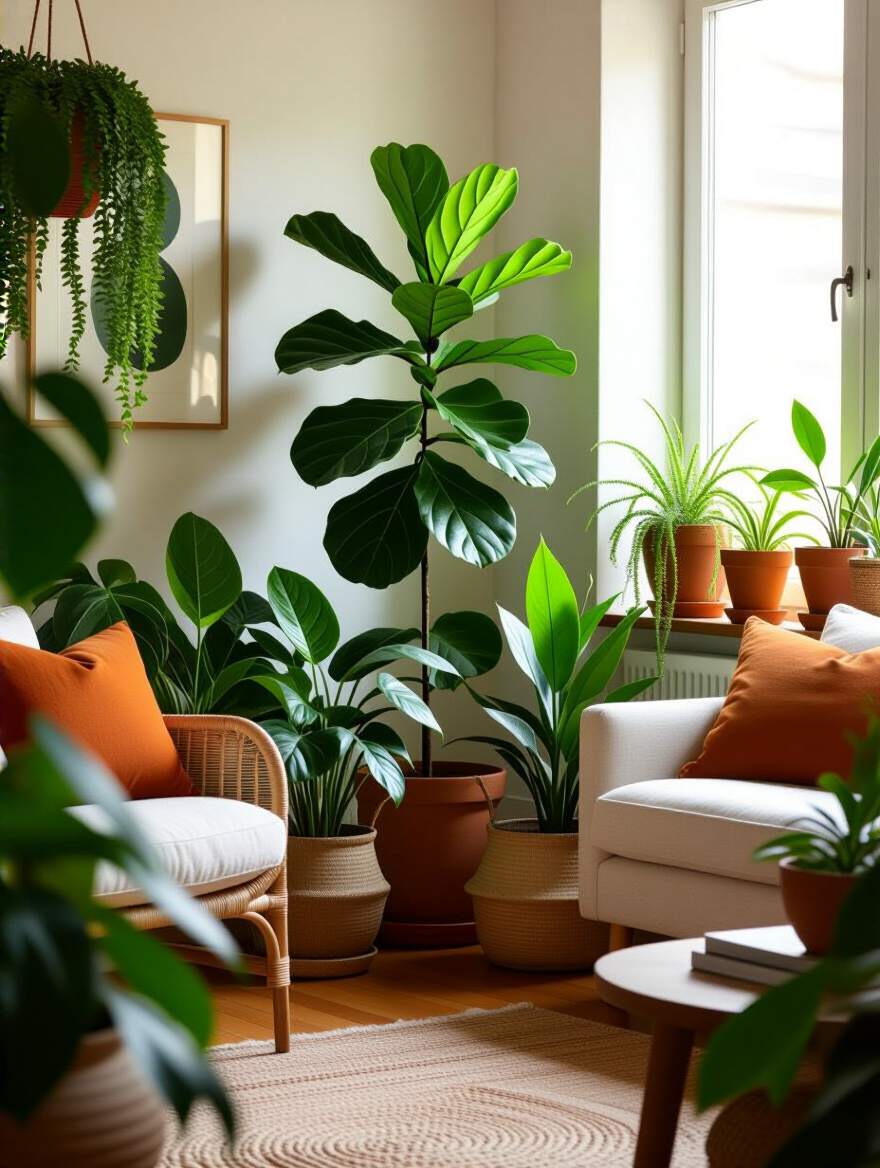
And don’t forget that the pot is part of the decor! Use this as another opportunity to add texture and eclectic flair. Mix modern ceramic planters with rustic terracotta pots and woven seagrass baskets. I once had a client who felt her minimalist living room was too sterile. We didn’t add any new furniture; we just brought in five plants of varying sizes and textures. It completely changed the energy of the room, making it feel softer, healthier, and more welcoming.
With your plants adding life, you can focus on styling the surfaces around them.
17. Craft Engaging Tabletop Vignettes
Your coffee table, console table, and side tables are not just places to put down a drink. They are stages for little moments of beauty. Crafting a vignette is like composing a tiny, still-life painting. You need an anchor—usually a stack of beautiful coffee table books or a Decorative Tray. This contains the composition.
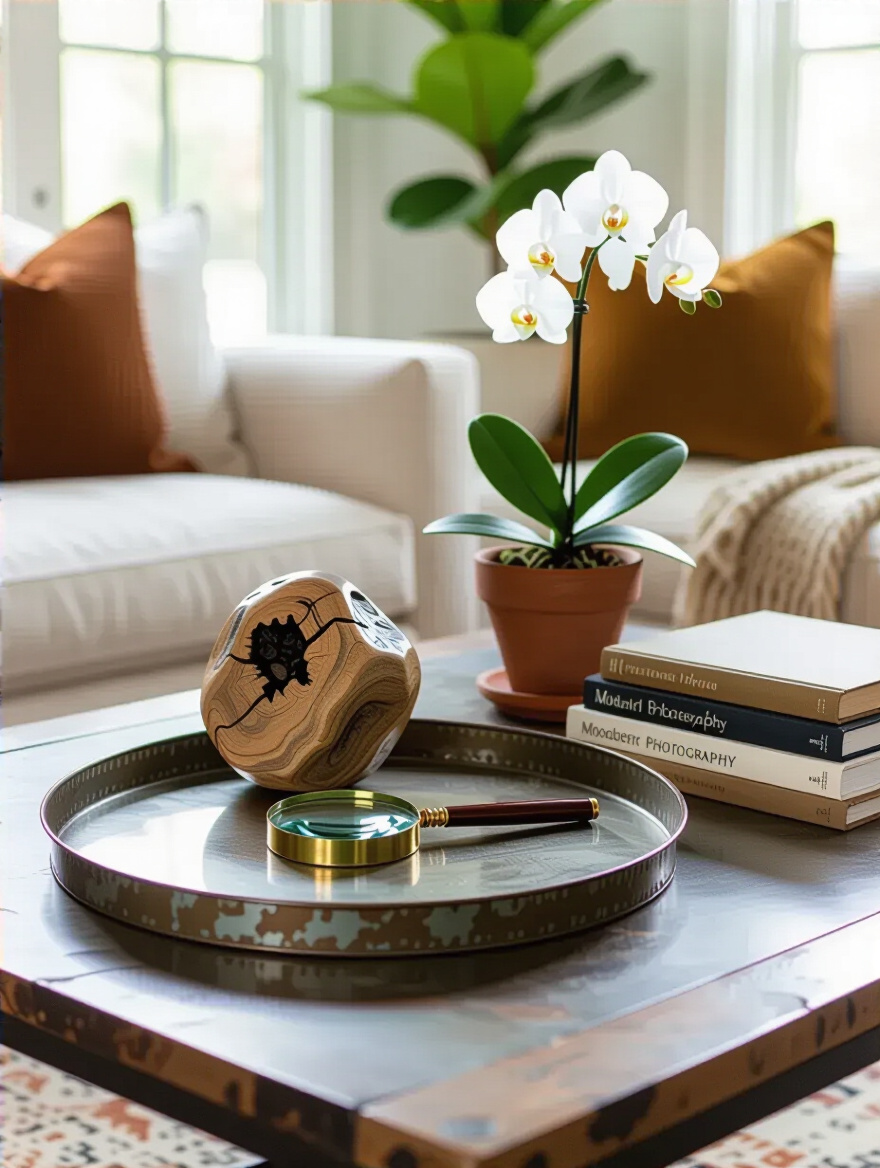
Inside your anchor, mix your elements. You need something living (a small plant or a bud vase with a single stem), something with height (a candle or a small sculpture), something personal (a found object or a small framed photo), and something with texture (a string of wooden beads, a piece of coral). This formula gives you a perfect balance of elements that feels collected and interesting without being cluttered.
And to add even more interest, you need to play with light and reflection.
18. Select Unique Decorative Mirrors Strategically
Mirrors are pure magic in a living room. They’re not just for checking your reflection; they are tools for manipulating light and space. A large mirror placed opposite a window can literally double the amount of natural light in a room. It also creates the illusion of depth, making a small room feel much larger. They are essentially windows you can place anywhere.

The key for an eclectic room is to choose a mirror with a unique frame that acts as a piece of art itself. An ornate, gilded antique mirror, a chunky carved wood frame, or a sleek, irregularly shaped modern mirror can all add incredible character. A great trick is to create a gallery wall of smaller, mismatched mirrors you’ve collected over time. The different shapes and frame styles create a beautiful, multifaceted reflection of the room that is always changing with the light.
Finally, don’t forget the sense of smell. It’s a powerful tool for comfort.
19. Add Scented Candles for Atmosphere
This is the final, invisible layer of coziness. Scent is directly tied to memory and emotion, and a beautiful, subtle fragrance can make a room feel instantly more welcoming and complete. Think beyond just “vanilla” or “ocean breeze.” Choose complex, sophisticated scents that match the vibe of your room—something like sandalwood and fig for a warm, earthy feel, or leather and oak for a moody, library-like space.
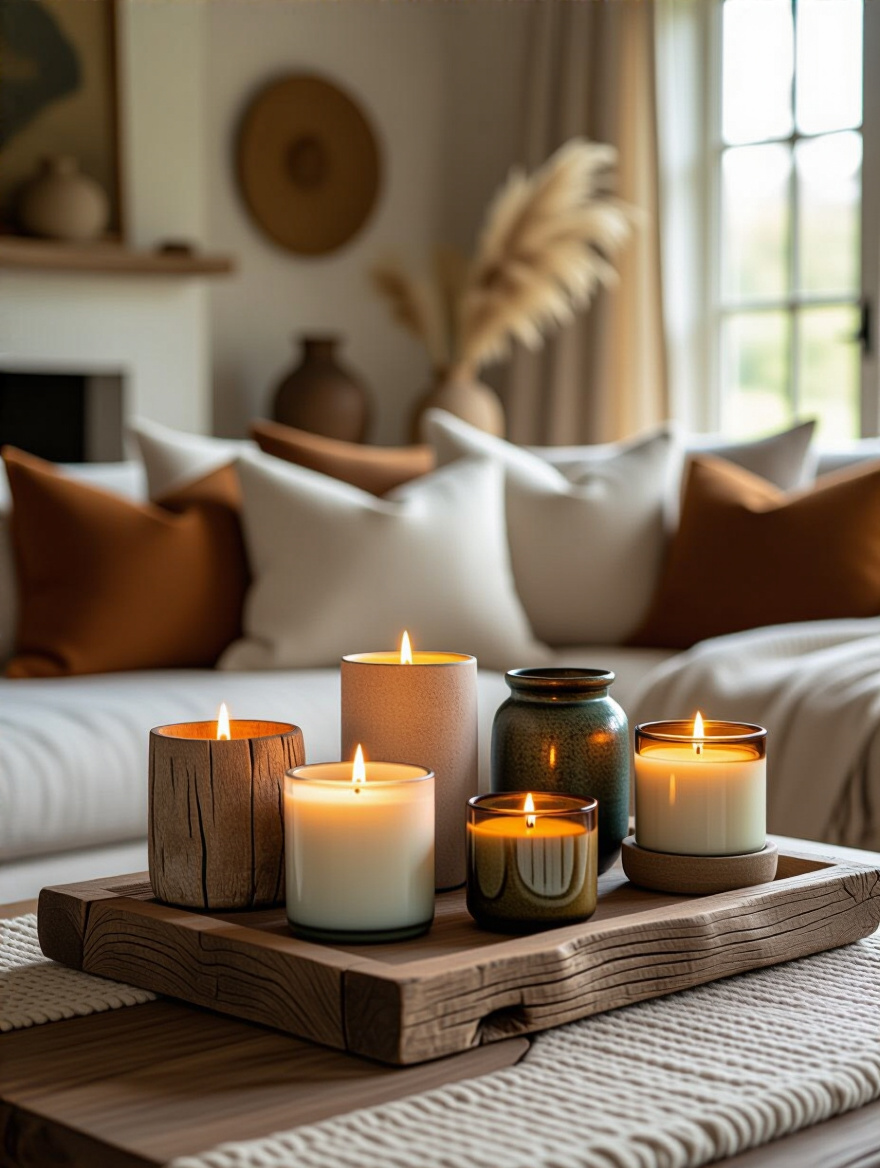
The vessel is just as important as the scent. Treat your candles like decorative objects. Look for ones in beautiful ceramic, amber glass, or heavy stone containers that add to your tabletop vignettes even when they’re not lit. The warm, flickering light of a candle also adds a beautiful, dynamic glow that no electric light can fully replicate. It’s that final touch that makes a space feel less like a decorated room and more like a sanctuary.
Refining & Personalizing Your Space
An eclectic room is never truly “done.” It’s a living, breathing thing that evolves with you. These final steps are about making sure it works for your life and continues to be a source of joy.
20. Create Defined Zones with Furniture Arrangement
This is about making your room work as hard as it looks good. Even in a small space, you can create different “zones” for different activities. The back of a sofa can create a great, subtle divider between your main seating area and a small workspace behind it. An area rug, as we talked about, can define a conversation zone. Two chairs and a small table pulled away from the main group can form an intimate spot for coffee.

The most important thing is to think about flow. Can you walk through the room without bumping into things? A common mistake I see is pushing all the furniture against the walls. Pull it in! Floating your sofa in the middle of the room can create a walkway behind it and make the space feel much more dynamic and intentional. Your goal is a room that feels intuitive to move through and live in.
To keep it that way, you need to be a ruthless editor.
21. Continuously Edit and Curate Your Selections
An eclectic room is always one step away from being a cluttered room. That’s why you have to be the bouncer at the door of your own home. Not everything gets to stay forever. Every few months, do a walkthrough and be honest. Do you still love that pillow? Does that stack of magazines need to be there? This is the “One In, One Out” rule. If you bring a new decorative object into the house, one has to go.
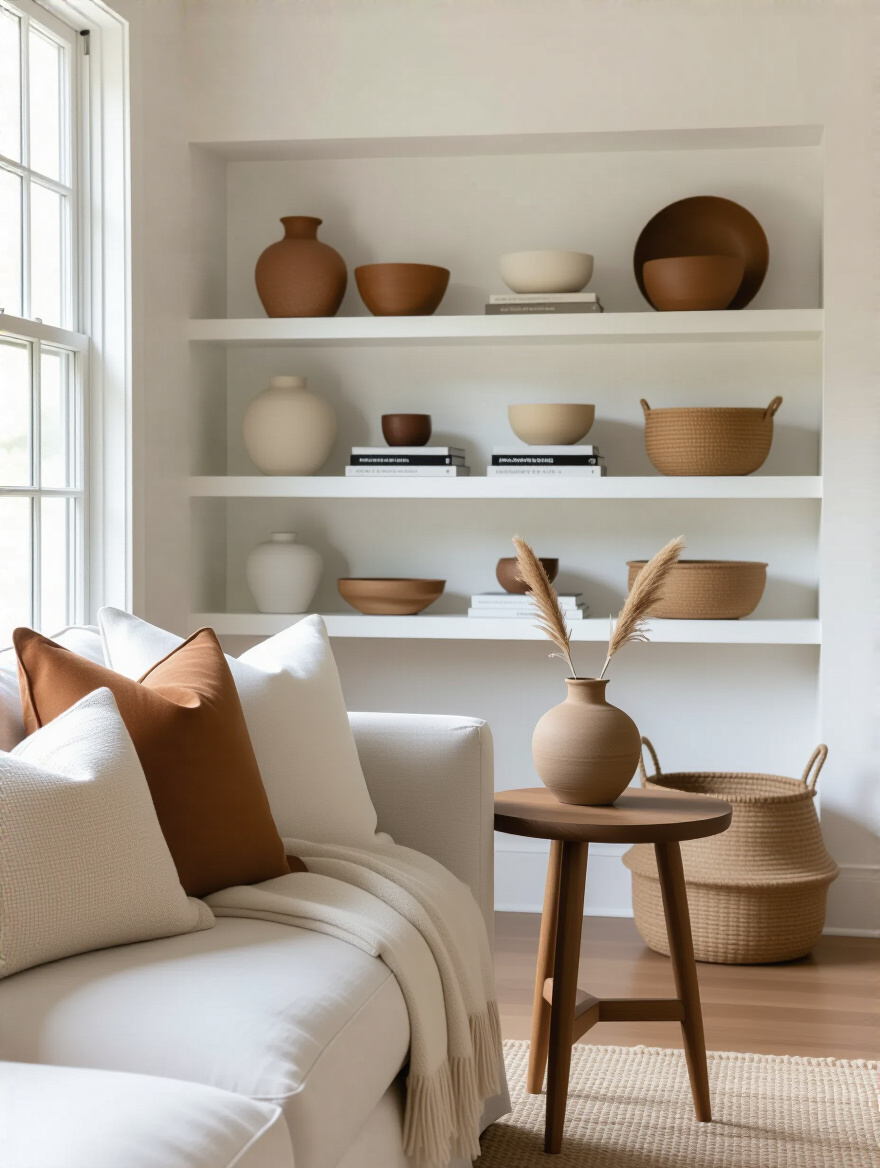
I have a “purgatory box” for this. If I’m on the fence about an object, I put it in the box in the closet. If I don’t miss it or even think about it for three months, it’s time for it to be donated. This keeps your collections feeling fresh and ensures that every single thing in your living room is something you truly love and that earns its keep. Negative space is your friend—let your beautiful things breathe.
And within that beautifully curated space, don’t forget to have a little fun.
22. Inject Humor or Whimsy Playfully
A home should not take itself too seriously. The most memorable and wonderful eclectic rooms always have a touch of something playful or unexpected that makes you smile. It could be a piece of art that’s a little cheeky, a lamp in the shape of a monkey, or a throw pillow with a wonderfully absurd pattern. It’s the thing that shows your personality and proves you’re not just following a formula.
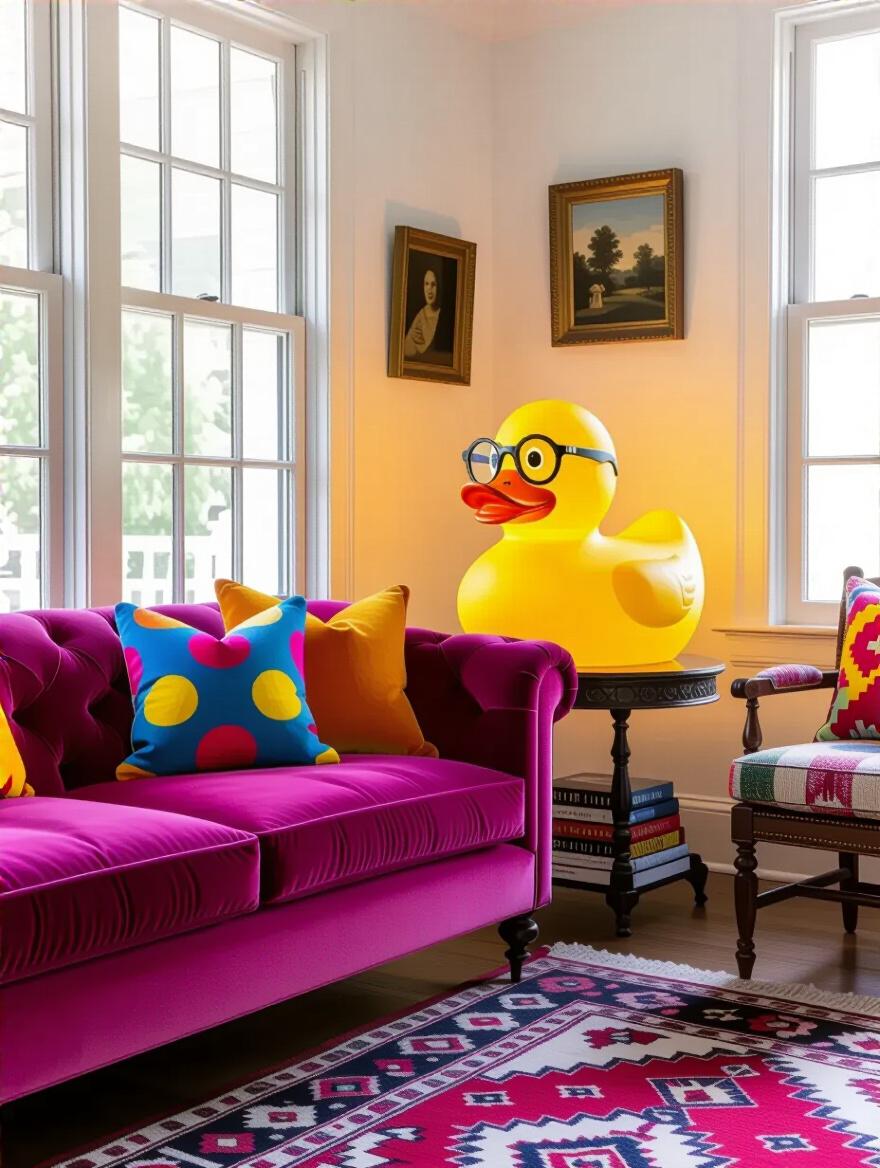
Juxtaposition is your best tool for this. Put something silly next to something serious. I once saw a very formal, traditional living room with a grand oil portrait over the fireplace. But if you looked closely, the subject in the portrait was a cat in a general’s uniform. It was brilliant. It showed the homeowners had incredible style, but also a great sense of humor. That little wink is what makes a house a home.
That brings us to the final, most important point of all.
23. Allow Your Eclectic Style to Evolve Organically
The most important thing to remember is that your living room is a marathon, not a sprint. It’s a diary of your life, told through objects and textiles. The goal is not to have it “finished” by next Tuesday. The best eclectic rooms are built over years, with pieces inherited from family, souvenirs from travel, art you fell in love with, and that perfect armchair you finally found after a year of searching.
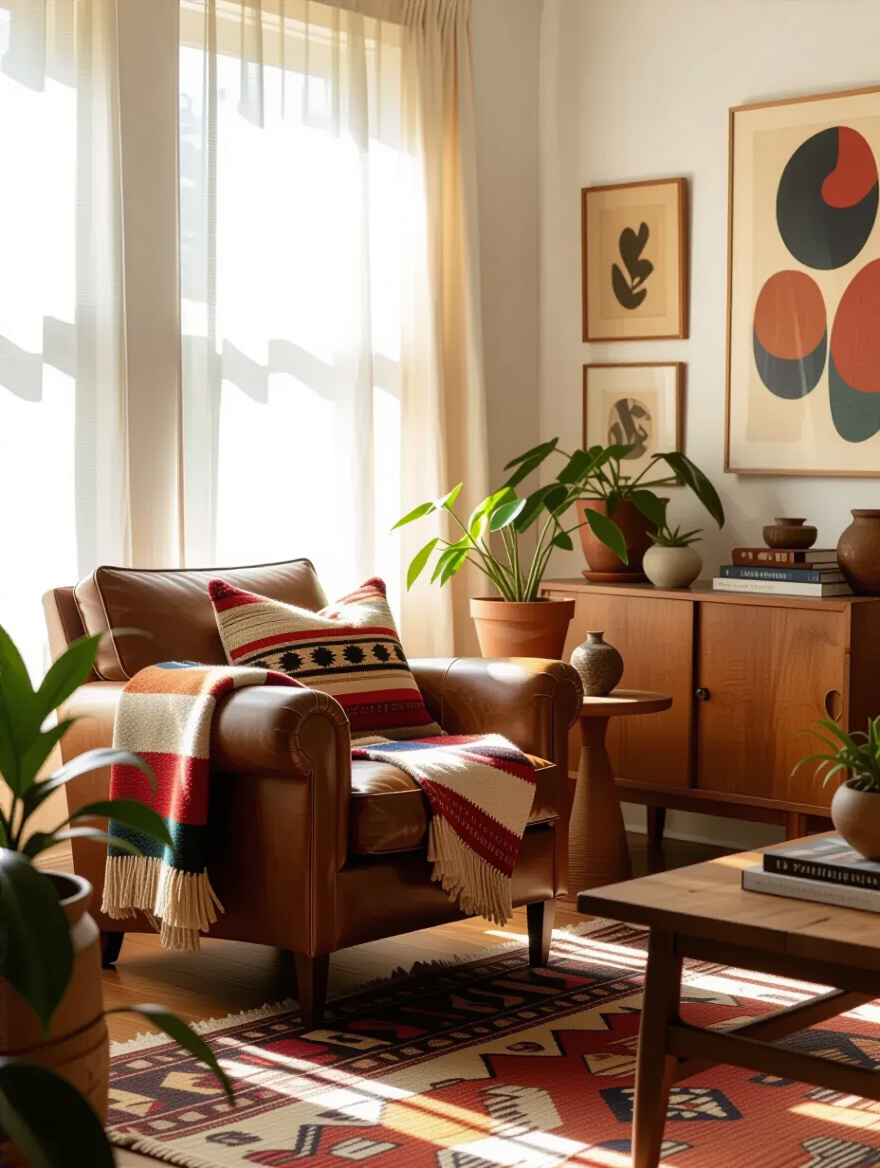
Embrace the journey. Let your space change as you change. If your style moves from boho to minimalist, slowly edit and swap things out. If you have a baby, your layout will need to adapt. A truly eclectic home is never static. It is a living, breathing reflection of you, and that is the most beautiful design style there is.
Conclusion
So there you have it. Creating a truly personal, cozy, eclectic living room isn’t about a shopping list; it’s about a mindset. It’s about becoming a thoughtful curator of your own life. You start with a strong, quiet foundation of color and scale, which gives you the freedom to layer in the things that make your heart sing—the nubby texture of a wool throw, the story of a vintage find, the vibrant color of a global textile. It’s about balancing hard with soft, old with new, serious with whimsical.
Stop worrying about matching. Start focusing on what harmonizes. Listen to your gut, collect things you truly love, and don’t be afraid to let your home tell your story, chapter by chapter. Now go pull that weird, wonderful chair out of the attic, pair it with a sleek modern lamp, and watch the magic happen. Your perfect, cozy, story-filled living room is waiting for you to bring it to life.
